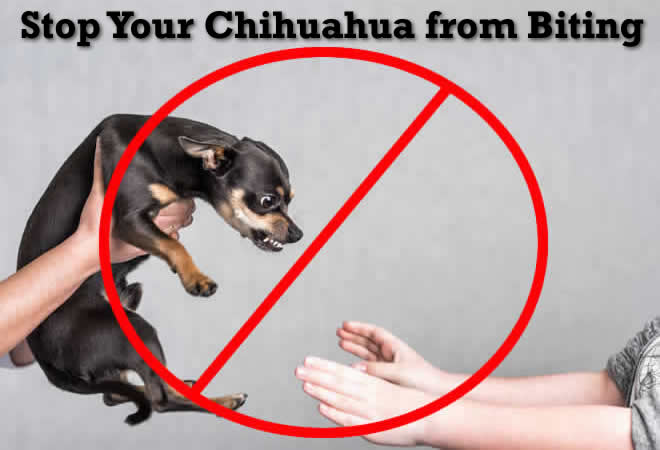
Biting is an instinctual characteristic shared by all dogs, and Chihuahuas are no exception.
Long before we domesticated them, dogs have used their teeth to kill prey, improve jaw strength, fend off predators, establish dominance in their pack’s social hierarchy, and play with other canines. Modern-day dogs have inherited this behavior from their ancestors, biting when provoked or otherwise stimulated. Unfortunately, this often results in owners, family members or complete strangers getting bit — behavior that should not be allowed.
Is a Biting Chihuahua Really That Bad?
According to the Centers for Disease Control and Prevention (CDC), more than 4.7 million dog bites occur in the U.S. each year, 800,000 of which require medical attention. Because of their small size, however, many owners turn a blind eye to their Chihuahua’s biting. After all, how much harm can a 5-pound Chihuahua really cause?
While a bite from a Chihuahua isn’t going to inflict the same damage as a bite from a larger dog like a pit bull or boxer, it can still leave a painful wound that’s prone to infection. There’s an old myth that a dog’s mouth is cleaner than a human’s mouth, but this isn’t a true. A dog’s saliva may contain one or more disease-causing pathogens, including Pasteurella multocida, Pasteurella canis, Staphylococcus, Streptococcus, and Capnocytophaga canimorsus. When a Chihuahua bites, germs such as these can enter through the wound and cause an infection.
Biting is also a financial liability for the owner. If someone is bitten by your Chihuahua while visiting your home, the victim could sue for the cost of medical bills, pain and suffering, and other related expenses. According to the Insurance Information Institute (III) and State Farm, roughly one-third of all homeowner’s insurance claims paid out in 2014 and 2015 involved dog bites.
Furthermore, it’s usually children between the ages of 5 and 9 who are bitten by dogs. Their small size, erratic movements, and inability to identify a dog’s temperament makes them a prime target for an attack. Children and Chihuahuas can safely coexist in the same home, but only after teaching both the boundaries of acceptable behavior.
Why Chihuahuas Bite
Chihuahuas possess innate behavioral traits passed down from their ancestors, including biting. Even the most docile “lap-friendly” Chihuahua can bite when pushed to the edge. To prevent this unacceptable behavior, owners must familiarize themselves with some of the reasons why Chihuahuas bite.
Teething
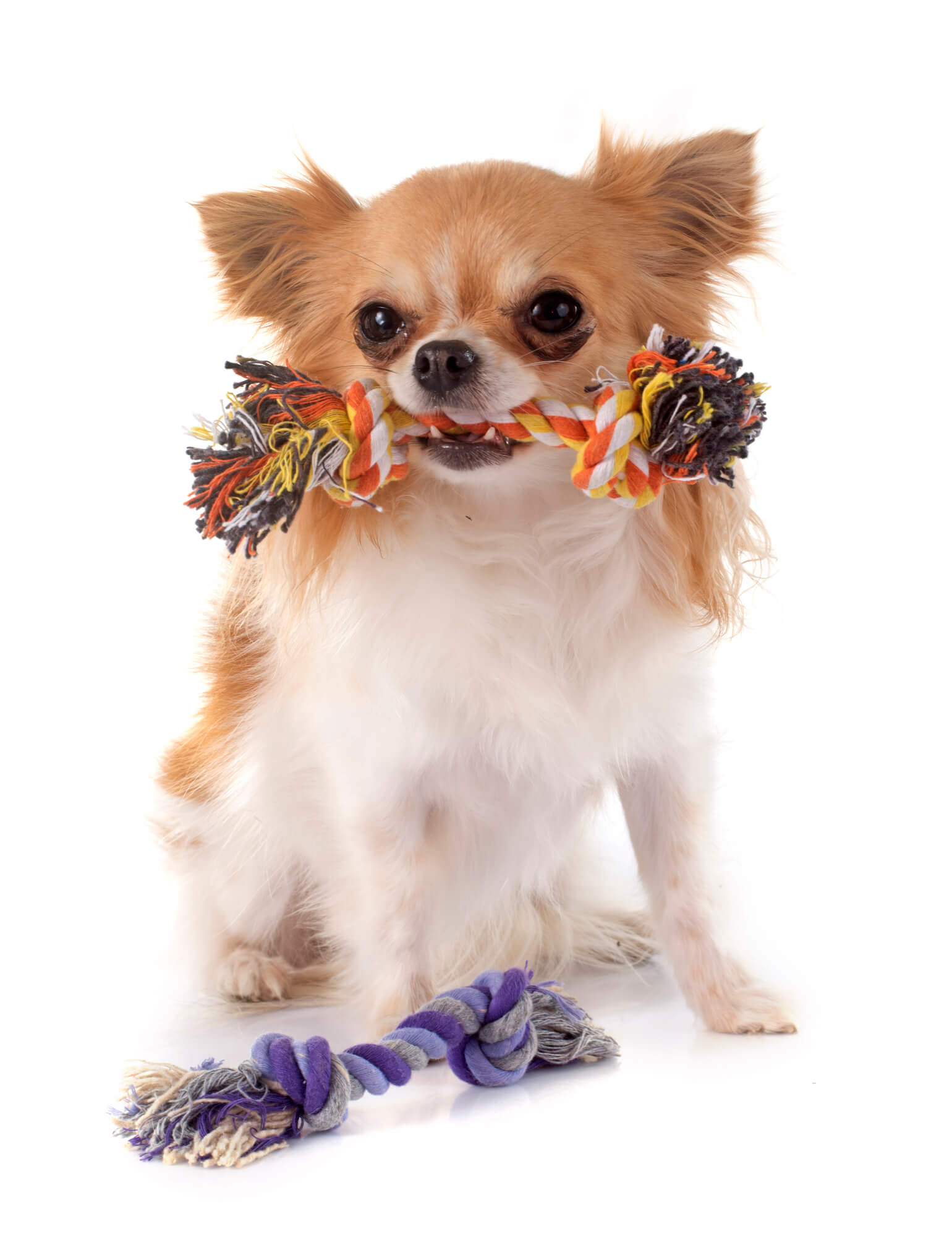
A Chihuahua puppy’s baby teeth (milk teeth) will erupt through his gums at 3 to 5 weeks of age, allowing the pup to transition from mother’s milk to dry food. To relieve the discomfort associated with this developmental process, puppies will bite and chew on just about anything they can get their paws on, including toys, socks, shoes, carpet, rugs or even your hand.
This behavior will continue until all 28 baby teeth have erupted. Your Chihuahua’s biting and chewing habits may return when his adult teeth erupt — usually occurring around 3 to 4 months of age.
Because of his young age, a puppy’s bite isn’t going to inflict much damage, nor does he intend to cause damage. Nonetheless, it’s important to begin teaching your Chihuahua early that biting is not acceptable.
Follow these tips to control your Chihuahua’s biting during the teething stage:
- Allow but don’t encourage your Chihuahua to bite your fingers.
- Teach bite inhibition by pulling your hand away saying “Ouch! That hurts!” when your Chihuahua bites too hard. This is the single most important thing you can do (we explain in greater detail below).
- Fill ice cube trays with low-sodium chicken or beef broth and place them in the freezer. Once frozen, offer the cool treat to your teething Chihuahua.
- Chilled carrots are an excellent and nutritious treat for a teething Chihuahua.
- Divert your Chihuahua’s chewing away from things like shoes and carpet by providing them proper toys. Rope toys are great because they can withstand countless hours of chewing. Kong toys are some of the toughest dog toys on the market, making them perfect for a teething Chihuahua. You can even fill them with water and freeze it for added relief of sore gums.
- Avoid plush toys, as they offer little-to-no relief of sore gums and are easily torn apart.
Maternal Aggression
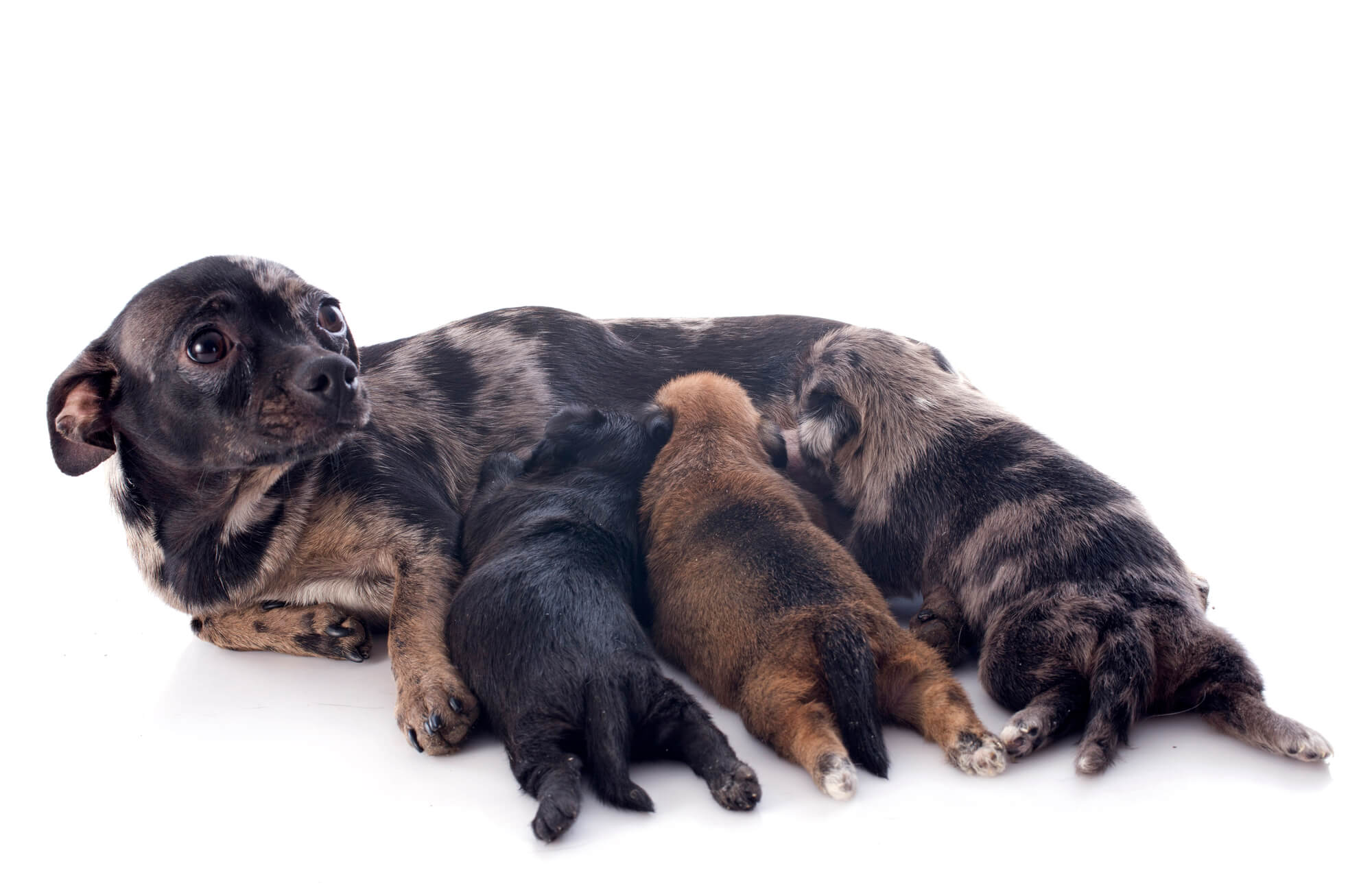
Female Chihuahuas are more likely to bite during the first 2-3 weeks after giving birth. Known as maternal aggression, this behavior is the result of powerful chemical alterations occurring throughout her body, including increased production of the hormones oxytocin and prolactin, and decreased production of progesterone.
Known as the “love hormone,” oxytocin is released by the hypothalamus section of the brain and is associated with maternal bonding, nurturing and attachment. It’s used to stimulate contractions during labor, helping the fetus move through the birth canal.
Levels of the calming hormone progesterone decrease when a female Chihuahua is about to give birth, triggering increased production of the hormone prolactin. In addition to stimulating milk production, prolactin is associated with nesting and maternal instinct. Veterinary experts believe prolactin is also primarily responsible for the behaviors exhibited by female dogs during pseudopregnancy. These hormonal changes experienced by a female Chihuahua during pregnancy, or shortly after, can make her more aggressive.
You shouldn’t attempt to correct a female Chihuahua’s maternal aggression, but rather keep your distance until her hormones go back to normal. If you need to inspect or weigh her puppies, wait until she leaves her nesting area for food or water. Her aggression should gradually fade with each passing day after giving birth, with her behavior returning to normal within 3 to 4 weeks.
Pain-Induced Aggression
Chihuahuas have a natural instinct to protect themselves from danger. When a Chihuahua experiences pain, he may lash out and bite the person nearest to him, regardless of whether that individual caused the pain. He doesn’t know who or what caused the pain, but his natural fight-or-flight instinct tells him to lash out at the nearest person or animal.
According to a study of 13 dogs conducted by researchers at Autonomous University, Barcelona, pain-inducted aggression was identified in all dogs. “Dogs that had never been aggressive before the onset of pain began to behave in this way in situations where an attempt is made to control them,” explained lead researcher Tomàs Camps. This study was published in the Journal of Veterinary Behavior— Clinical Applications and Research.
If your Chihuahua suffers from a medical condition like patellar luxation, which is common in this breed, he may exhibit aggressive behavior when touched in the affected knee. Owners and family members should use caution when handling a Chihuahua who’s suffering from painful physical conditions or injuries to avoid being bit.
A Chihuahua doesn’t necessarily have to be suffering from an injury or medical condition to exhibit pain-induced aggression. Toy breeds are most susceptible to pain-induced aggression because of their small size and heightened sensitivity towards pain. If a child (or adult) presses pulls, pinches or pushes your Chihuahua with too much force, he or she may get bit.
Signs that your Chihuahua is in pain may include:
- Aggressive behavior
- Flattened ears
- Loss of appetite
- Not interested in playing
- Reluctance to accept treats
- Yelping, whining or growling when touched (reactions such as these typically occur when a specific spot is touched)
- Difficulty jumping and climbing stairs
- Heavy panting
- Excessive paw-licking
- Difficulty sleeping
If you believe your canine companion is suffering from pain, schedule an appointment with your veterinarian ASAP. After performing an examination, your veterinarian can help to identify the cause of the pain and offer advice on treatment and pain medication options.
Past Abuse
According to the study “Behavioral and Psychological Characteristics of Canine Victims of Abuse” published in the Journal of Applied Animal Welfare Science (JAAWS), dogs with a history of past abuse were more likely to exhibit aggressive behavior towards unfamiliar people and unfamiliar dogs.
If you adopted a Chihuahua from a shelter or rescue, perhaps his biting is the result of abuse by a former owner. You can check with the organization from which you adopted your Chihuahua to see if there’s any history of abuse, but many cases go unreported.
Whether it’s physical abuse, social isolation, yelling/verbal punishment, confinement to a chain, or removing the pup from its mother too early, abuse comes in many different forms. Some Chihuahuas recover quickly from such abuse, while others have lasting emotional scars that sow the seeds for aggressive behavior.
Teaching a Chihuahua with past abuse to trust humans again isn’t an easy task, nor will it happen overnight. With time, patience, dedication and lots of affection, however, you can help your Chihuahua overcome these negative feelings.
Fear
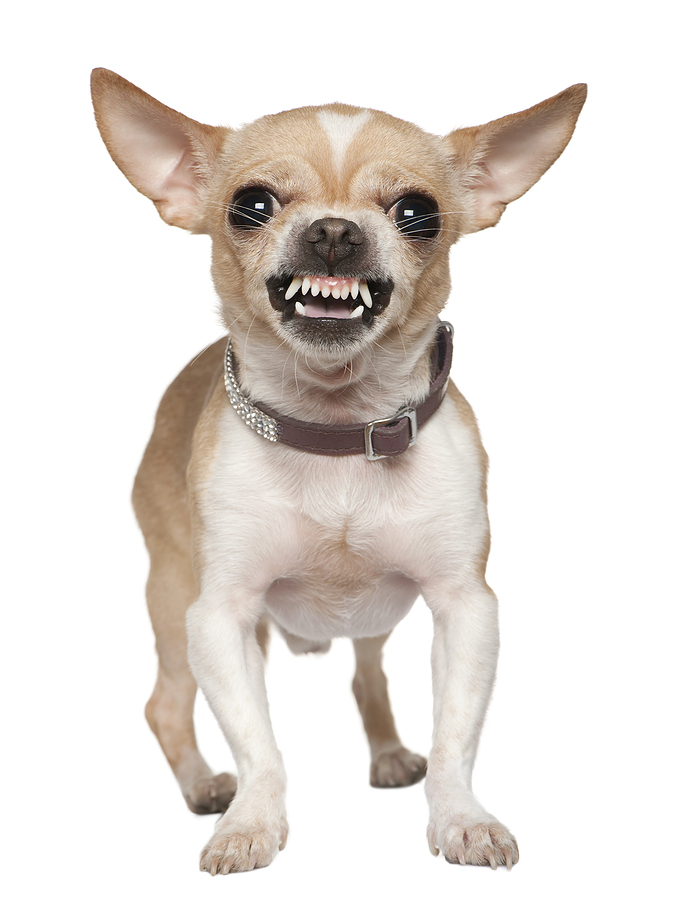
Chihuahua is more likely to bite another animal or person if he fears for his safety. Veterinarians are often the target of such aggression, simply because dogs are fearful of unfamiliar people and situations. When you take your Chihuahua to see a new veterinarian for the first time, he may growl and nip during the examination. The veterinarian isn’t going to harm your canine companion, but he or she is still perceived as a potential threat.
Because the victims of fear bites are typically strangers, owners should tell strangers not to pet or otherwise touch their Chihuahua. It’s not uncommon for strangers to stop and pet dogs at the park. In doing so, they place themselves at risk of being bitten. If you walk your Chihuahua in a park or other public area, politely decline any requests to pet your canine companion, unless your Chihuahua is familiar with the individual.
Socialization is key to nipping fear-inducted biting in the bud.
Territorial
Chihuahuas have a natural instinct to protect what they believe is their property, including toys, food, treats, water, beds, people and home. Known as territorial aggression, a Chihuahua is more likely to bite another person or animal if that person or animal encroaches upon their property. The purpose of this isn’t to harm the individual but to make him or her go away.
A prime example of territorial aggression is when a postal worker delivers mail to a home, only to get chased and potentially bitten by the homeowner’s dog. According to a report by the United States Postal Service (USPS), 6,549 of its employees were attacked by dogs in 2015. The dog perceives the postal worker as encroaching upon HIS territory, so his natural instinct is to chase the postal worker away.
Preventing bites from territorial aggression begins with teaching your Chihuahua that it’s YOUR property and that YOU will protect it. If he acts aggressively when a stranger knocks on the door, show him that it’s okay by asking a friend to come over and knock and enter through the front door, rewarding your Chihuahua with a treat afterward.
If your Chihuahua is aggressive in a particular area, such as the corner of the living room, give him access to the area only when he’s not displaying signs of aggression. You can do the same if he’s aggressive around a toy, taking the toy away and giving it back when he’s docile. Some experts also recommend making dogs “work” for their toys and property by performing basic obedience commands like sit or heel, after which the dog is rewarded with the toy or item. Along with regular socialization and positive reinforcement, this can put an end to territorial aggression.
To prevent territorial aggression around food, carefully approach your Chihuahua with a treat while he’s eating. He should stop eating momentarily to accept the treat, after which you should walk away and wait a few minutes before returning with another treat. This shows your Chihuahua that it’s not always bad when someone enters his territory.
Illness
Certain illnesses and diseases may trigger aggressive behavior in Chihuahuas. Hypothyroidism is one such disease that can make an otherwise docile dog more likely to bite. Located next to the larynx (voice box), the thyroid gland is a small gland that’s responsible for producing thyroid hormones, which regulate healthy metabolic functions. Hypothyroidism occurs when the thyroid gland doesn’t produce enough of these hormones.
While hypothyroidism occurs mostly in larger breeds, Chihuahuas may develop it as well. A simple blood test performed at the veterinarian’s office can reveal whether your Chihuahua is suffering from this disease. Thyroid hormone supplements like Levothyroxine (Soloxine) are often prescribed to treat hypothyroidism in dogs.
Symptoms of hypothyroidism may include:
- Aggressive behavior
- Lethargy
- Hair loss and excessive shedding
- Sudden weight gain
- Hyperpigmentation of the skin
- High cholesterol
- Anemia
Lyme disease is another disease that’s been linked to aggressive behavior in dogs. Transmitted through the bite of an infected tick, it can cause swollen joints, swollen lymph nodes, lethargy, loss of appetite, as well as neurological symptoms like irritability, confusion and aggression. However, only 5-10% of dogs with Lyme disease show symptoms.
There’s a vaccine available for Lyme disease, but many veterinarians recommend traditional tick prevention methods instead due to the risk of adverse reactions from vaccination.
Teaching Your Chihuahua Not to Bite
There’s no universal training technique that will stop all Chihuahuas from biting. Dogs bite for many reasons, and the method for stopping this behavior varies depending on the trigger. With that said, the following tips can greatly reduce many instances of biting and other forms of aggression in Chihuahuas.
Don’t Punish for Growling
Many owners scold or otherwise punish their Chihuahuas for growling. In doing so, they eliminate a key warning sign that precedes biting. If you teach your Chihuahua that growling is bad, perhaps he’ll bite without warning the next time he’s provoked. The possibility of biting is still there, but the warning sign — growling — is removed.
Allowing your Chihuahua to growl may sound counterproductive if you’re trying to teach him not to bite, but it’s actually beneficial. Owners can teach their children to back away from the Chihuahua when he growls to avoid getting bit.
Growling may also reveal the cause of his aggression. If your Chihuahua growls when picked up, perhaps he’s suffering from a painful injury or medical condition. If he growls when another pet approaches his crate, his aggression is territorial.
Teach Bite Inhibition
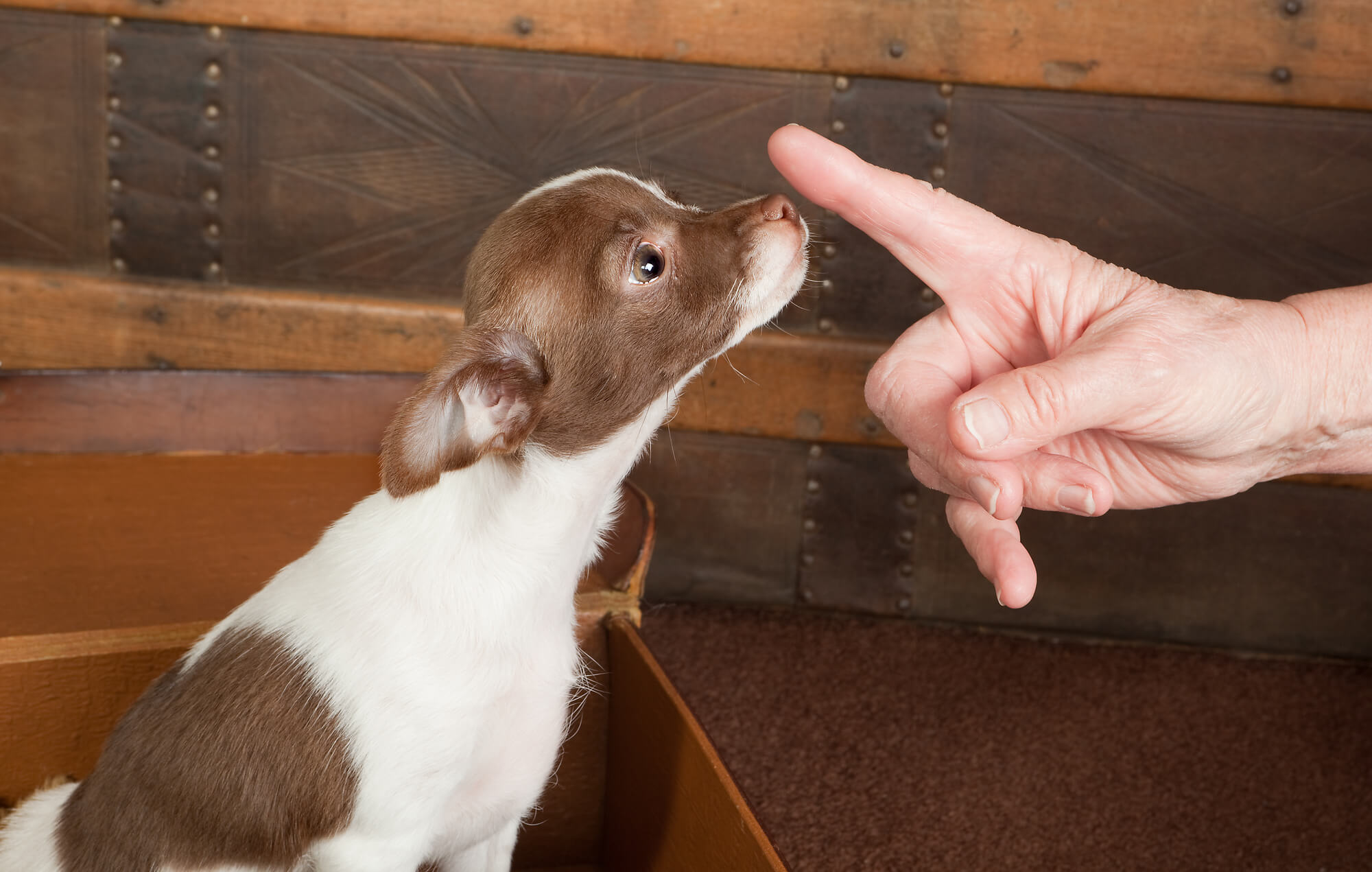
Bite inhibition refers to a dog’s ability to control the force of his bite. When you give your Chihuahua a treat, for instance, he shouldn’t bite your hand using the full strength of his jaw. If he knows bite inhibition, he’ll accept the treat more cautiously to prevent injuring you. The goal isn’t to prevent your Chihuahua from biting, but rather to teach him to control the force of his of bite.
Puppies learn bite inhibition at an early age while nursing and playing with their littermates. If a puppy bites one his littermates too hard, the littermate may let out a high-pitched yelp, saying “You bit me too hard — and it hurt!” The same goes for puppies while nursing: biting the mother too hard may cause her to get up and walk away. If a puppy wants to play and nurse, he must learn to control his bite.
This is one of the reasons why puppies should stay with their mother for at least eight weeks. If a puppy is removed too early, he’s less likely to develop bite inhibition through playing and nursing. The same goes for singletons who are born without playmates.
Here are the three rules to follow when teaching bite inhibition:
- Respond to forceful bites. When your Chihuahua bites too hard, respond by pulling your hand away and saying “Ouch, that hurt!” You should then ignore him for the next few minutes to discourage forceful biting.
- Be consistent with your training efforts. Consistency is key when teaching your Chihuahua bite inhibition. If you respond with a loud “Ouch” on one occasion but not the next, it confuses him by sending mixed messages.
- Reinforce into adulthood. Bite inhibition is best taught at an early age, while the puppy is still young. However, you should continue to reinforce it well into your Chihuahua’s adulthood.
Socialization
Chihuahuas are much more likely to exhibit aggressive behavior if they aren’t socialized. When a Chihuahua isn’t exposed to other people, animals and environments, he’s likely to develop fear-induced aggression, such as biting an unfamiliar person’s hand.
One study conducted by researchers from Cummings School of Veterinary Medicine at Tufts University found that unsocialized puppies were 580 times more likely to develop aggression problems later in life.
The idea behind socialization is to show your Chihuahua that other people and animals aren’t bad, preferably while he’s still a puppy. Puppies are most sensitive to socialization between the ages of 3 and 16 weeks, making this is a critical time to prevent aggression. If your Chihuahua has positive experiences with other people and animals at a young age, he’ll develop a more relaxed disposition towards unfamiliar faces in the future.
Here are some tips to follow when socializing your Chihuahua:
- Make sure your Chihuahua is up to date on his vaccinations before exposing him to other people and animals.
- Take a trip to the pet store with your Chihuahua.
- Bring your Chihuahua on car trips (just don’t leave him in the car).
- Go on walks with your Chihuahua, such as dog parks, around the neighborhood, wooded trails, etc.
- Play fetch with your Chihuahua outdoors.
- When taking your Chihuahua to a dog park, walk him around the outside of the fence first.
- Take your Chihuahua to friends’ and family members’ homes.
- Invite friends or family members over to your home, encouraging them to play with your Chihuahua.
- Sign up for a group-based obedience training class.
- Reward your Chihuahua with a treat after each socialization experience.
Spaying/Neutering
Spaying or neutering may reduce aggression in Chihuahuas. According to a study conducted by researchers from the University of California, intermale aggression was reduced in 60% of male dogs by neutering, with a rapid reduction of aggression in 25% and a gradual reduction in 35%.
Neutering results in lower levels of testosterone, reducing behavior associated with this hormone such as urinating to mark territory, hyperactivity, running away, and aggression.
Spaying a female Chihuahua eliminates her heat cycle, and subsequently the behaviors associated with going into heat. It may also reduce female hormone-driven behavior, including nest guarding in pseudopregnancy.
In the past, it was widely believed that neutering male dogs before puberty was necessary to prevent these behavioral problems. A study cited by the American Veterinary Medical Association (AMVA), however, suggests that neutering male dogs in adulthood is just as effective at reducing aggression as neutering before puberty.
Professional Help for Biting and Aggression
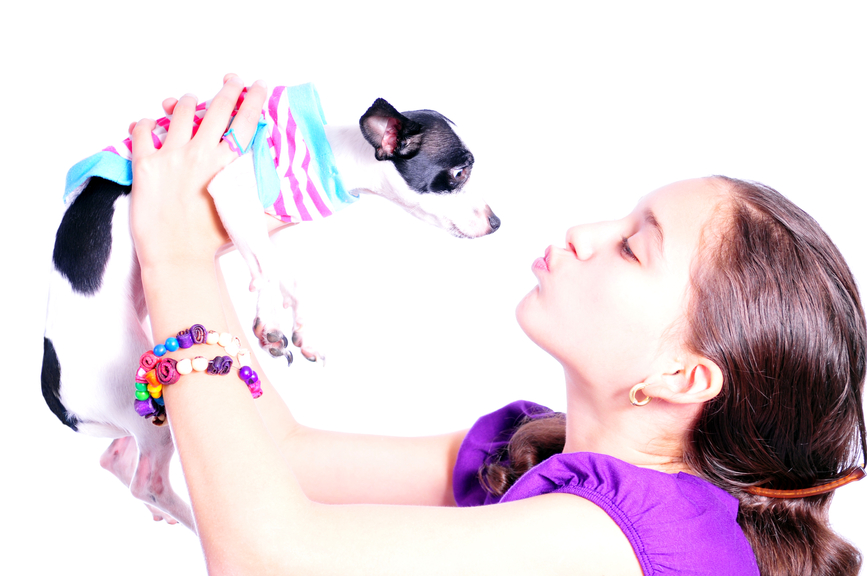
When all else fails, seek professional help for your Chihuahua’s behavior. The American Society for the Prevention of Cruelty to Animals (ASPCA) recommends consulting with a Certified Applied Animal Behaviorist (CAAB) or a board-certified veterinary behaviorist.
Alternatively, you can seek professional help from a Certified Professional Dog Trainer (CPDT) or member of the Association of Pet Dog Trainers (APDT).
The bottom line is that you shouldn’t throw in the towel just because your previous training efforts have failed.
References:
https://www.humanesociety.org/resources/stop-your-dogs-chewing